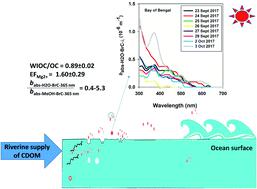当前位置:
X-MOL 学术
›
Environ. Sci.: Processes Impacts
›
论文详情
Our official English website, www.x-mol.net, welcomes your
feedback! (Note: you will need to create a separate account there.)
Evidence for brown carbon absorption over the Bay of Bengal during the southwest monsoon season: a possible oceanic source.
Environmental Science: Processes & Impacts ( IF 4.3 ) Pub Date : 2020-07-20 , DOI: 10.1039/d0em00111b Poonam Bikkina 1 , Srinivas Bikkina 2 , Kimitaka Kawamura 2 , A K Sudheer 3 , G Mahesh 3 , S Kuswanth Kumar 4
Environmental Science: Processes & Impacts ( IF 4.3 ) Pub Date : 2020-07-20 , DOI: 10.1039/d0em00111b Poonam Bikkina 1 , Srinivas Bikkina 2 , Kimitaka Kawamura 2 , A K Sudheer 3 , G Mahesh 3 , S Kuswanth Kumar 4
Affiliation

|
The near UV-visible light-absorbing organic carbon (OC) of ambient aerosols, referred to here as brown carbon (BrC), significantly influences the atmospheric radiative forcing on both regional and global scales. Here, we documented BrC absorption in the aqueous and methanol extracts of marine aerosols collected over the Bay of Bengal (BoB: September–October 2017) and a city, Visakhapatnam (May–June 2018), in southern India during the southwest monsoon (i.e., a transition period with weak continental impact). The absorption spectra of BrC over the BoB showed several peaks around 300–400 nm and differ from those observed over Visakhapatnam. The absorption coefficient of BrC over the BoB, unlike Visakhapatnam data, does not seem to covary with other chemical proxies of biomass burning (non-sea-salt or nss-K+) and coal combustion (nss-SO42−) in the continental outflows, suggesting a different source of BrC over the BoB. Besides, we observed higher proportions of water-insoluble organic carbon (WIOC/OC: 0.89 ± 0.02) and significant enrichment of Mg2+ over Na+ (i.e., relative to seawater) in BoB aerosols. This result and the backward air mass trajectories both hinted their major source of OC from marine-derived organic matter. In contrast, the absorption spectra of BrC over Visakhapatnam are like those from biomass burning emissions in the Indo-Gangetic Plain. This observation is further supported by the satellite-based fire counts and backward air mass trajectories. Therefore, our study underscores the BrC aerosols from the oceanic sources and southern India, hitherto unknown, and can improve our understanding of the regional climate effects of carbonaceous aerosols if included in models.
中文翻译:

西南季风季节孟加拉湾棕色碳吸收的证据:一个可能的海洋来源。
环境气溶胶的近紫外可见光吸收性有机碳(OC),在这里称为棕碳(BrC),在区域和全球范围内都严重影响大气的辐射强迫。在这里,我们记录了西南季风(即印度南部)在孟加拉湾(BoB:2017年9月至10月)和维萨卡帕特南市(2018年5月至2018年6月)收集的海洋气溶胶的水和甲醇提取物中的BrC吸收。,这对大陆影响不大。在BoB上BrC的吸收光谱在300-400 nm附近显示了几个峰,与在Visakhapatnam上观察到的峰不同。与Visakhapatnam数据不同,BrC在BoB上的吸收系数似乎与生物质燃烧的其他化学代理(非海盐或nss-K)无关+)和大陆流出处的燃煤(nss-SO 4 2-),表明在BoB上有不同的BrC来源。此外,我们观察到较高比例的水不溶性有机碳(WIOC / OC:0.89±0.02)和Mg 2+在Na +(即(相对于海水而言)的BoB气溶胶。这一结果和向后的空气质量轨迹都暗示了它们是海洋来源的有机质中主要的OC来源。相比之下,维萨卡帕特南地区BrC的吸收光谱类似于印度-印度洋平原生物质燃烧排放的吸收光谱。基于卫星的火计数和向后的空气质量轨迹进一步支持了这一观察结果。因此,我们的研究强调了迄今未知的来自海洋和印度南部的BrC气溶胶,如果包括在模型中,则可以增进我们对碳质气溶胶对区域气候影响的理解。
更新日期:2020-08-19
中文翻译:

西南季风季节孟加拉湾棕色碳吸收的证据:一个可能的海洋来源。
环境气溶胶的近紫外可见光吸收性有机碳(OC),在这里称为棕碳(BrC),在区域和全球范围内都严重影响大气的辐射强迫。在这里,我们记录了西南季风(即印度南部)在孟加拉湾(BoB:2017年9月至10月)和维萨卡帕特南市(2018年5月至2018年6月)收集的海洋气溶胶的水和甲醇提取物中的BrC吸收。,这对大陆影响不大。在BoB上BrC的吸收光谱在300-400 nm附近显示了几个峰,与在Visakhapatnam上观察到的峰不同。与Visakhapatnam数据不同,BrC在BoB上的吸收系数似乎与生物质燃烧的其他化学代理(非海盐或nss-K)无关+)和大陆流出处的燃煤(nss-SO 4 2-),表明在BoB上有不同的BrC来源。此外,我们观察到较高比例的水不溶性有机碳(WIOC / OC:0.89±0.02)和Mg 2+在Na +(即(相对于海水而言)的BoB气溶胶。这一结果和向后的空气质量轨迹都暗示了它们是海洋来源的有机质中主要的OC来源。相比之下,维萨卡帕特南地区BrC的吸收光谱类似于印度-印度洋平原生物质燃烧排放的吸收光谱。基于卫星的火计数和向后的空气质量轨迹进一步支持了这一观察结果。因此,我们的研究强调了迄今未知的来自海洋和印度南部的BrC气溶胶,如果包括在模型中,则可以增进我们对碳质气溶胶对区域气候影响的理解。











































 京公网安备 11010802027423号
京公网安备 11010802027423号